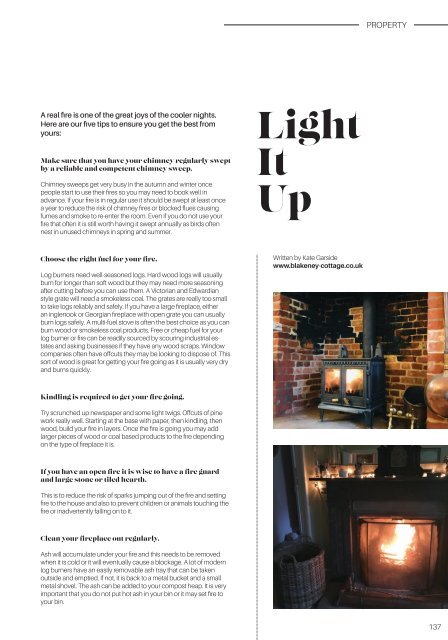Create successful ePaper yourself
Turn your PDF publications into a flip-book with our unique Google optimized e-Paper software.
PROPERTY<br />
A real fire is one of the great joys of the cooler nights.<br />
Here are our five tips to ensure you get the best from<br />
yours:<br />
Make sure that you have your chimney regularly swept<br />
by a reliable and competent chimney sweep.<br />
Chimney sweeps get very busy in the autumn and winter once<br />
people start to use their fires so you may need to book well in<br />
advance. If your fire is in regular use it should be swept at least once<br />
a year to reduce the risk of chimney fires or blocked flues causing<br />
fumes and smoke to re-enter the room. Even if you do not use your<br />
fire that often it is still worth having it swept annually as birds often<br />
nest in unused chimneys in spring and summer.<br />
Light<br />
It<br />
Up<br />
Choose the right fuel for your fire.<br />
Log burners need well-seasoned logs. Hard wood logs will usually<br />
burn for longer than soft wood but they may need more seasoning<br />
after cutting before you can use them. A Victorian and Edwardian<br />
style grate will need a smokeless coal. The grates are really too small<br />
to take logs reliably and safely. If you have a large fireplace, either<br />
an inglenook or Georgian fireplace with open grate you can usually<br />
burn logs safely. A multi-fuel stove is often the best choice as you can<br />
burn wood or smokeless coal products. Free or cheap fuel for your<br />
log burner or fire can be readily sourced by scouring industrial estates<br />
and asking businesses if they have any wood scraps. Window<br />
companies often have offcuts they may be looking to dispose of. This<br />
sort of wood is great for getting your fire going as it is usually very dry<br />
and burns quickly.<br />
Written by Kate Garside<br />
www.blakeney-cottage.co.uk<br />
Kindling is required to get your fire going.<br />
Try scrunched up newspaper and some light twigs. Offcuts of pine<br />
work really well. Starting at the base with paper, then kindling, then<br />
wood, build your fire in layers. Once the fire is going you may add<br />
larger pieces of wood or coal based products to the fire depending<br />
on the type of fireplace it is.<br />
If you have an open fire it is wise to have a fire guard<br />
and large stone or tiled hearth.<br />
This is to reduce the risk of sparks jumping out of the fire and setting<br />
fire to the house and also to prevent children or animals touching the<br />
fire or inadvertently falling on to it.<br />
Clean your fireplace out regularly.<br />
Ash will accumulate under your fire and this needs to be removed<br />
when it is cold or it will eventually cause a blockage. A lot of modern<br />
log burners have an easily removable ash tray that can be taken<br />
outside and emptied. If not, it is back to a metal bucket and a small<br />
metal shovel. The ash can be added to your compost heap. It is very<br />
important that you do not put hot ash in your bin or it may set fire to<br />
your bin.<br />
137

















